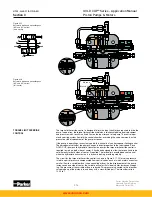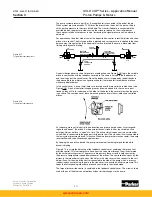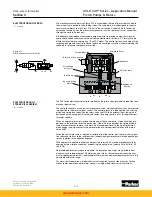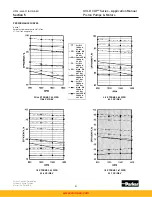
HY28-2668-01/GC/NA,EU
GOLD CUP
®
Series - Application Manual
Piston Pumps & Motors
4.5
Parker Hannifin Corporation
Hydraulic Pump Division
Marysville, Ohio USA
Section 4
Case pressure replenishing will prevent cavitation of the hydrostatic pump during periods
when the combined leakages of the pump and actuators exceed the replenishment flow from
the charge pump(s). Under these conditions the flow introduced into the loop from the case
drains is equal to the difference between leakage and charge pump flow. It should be used
only for momentary requirements such as those that occur from low pump shaft speeds.
For applications which use multiple actuators or actuators with high internal leakage, it may
be necessary to introduce additional replenishment flow from another source. These applica-
tions will suffer prolonged loss of replenishing pressure and temperatures and contamination
levels will rise if case pressure replenishing is relied upon.
Circuits with high pressure drops will heat rapidly unless additional replenishing is added to
flush hot oil from the loop. These circuits include closed circuit hoist circuits with counter bal-
ance valves or traction circuits with flow dividers.
Circuits which have long lines or other forms of large compressible volumes should have
additional replenishment flows available; especially if rapid pressure changes or reversals are
to be encountered. This flow may be obtained from accumulators plumbed into the auxiliary
replenishment port. Under these conditions, case pressure replenishment offers little help.
Additional replenishing flows may be obtained from additional pumps or return oil from other
circuits. (See Figure 4.7). Flow from an additional pump may be introduced to the auxiliary
replenishment port continuously at replenishing pressure. Return flows from other circuits
should be plumbed so they are introduced only as required. If these flows are cooled and
filtered they may be introduced continuously.
Unlike electric motors, diesel engines are very reluctant to start under high loads, especially
when cold. It is good practice to insure that the load is removed or disconnected prior to
cranking. Manual or electrically controlled clutches are sometimes used, but are costly or
inconvenient. The GOLD CUP
®
line of pumps offers a number of convenient and inexpensive
methods for relieving loads during engine startup.
A small electrically operated two-way valve which vents the pressure compensator override
can be used. Wired to the start position of the starter switch, the valve shifts to the open
position during cranking and vents the compensator. In this condition, the pump is used to
destroke its own rocker cam. When the engine fires and cranking stops, the valve closes, al-
lowing the pump to readily follow rotary servo input commands.
A small capacity high pressure accumulator connected to the compensator vent port can pro-
vide an initial no-load period for cranking. With a low pressure precharge, the accumulator will
be empty of oil when the pump is at rest, but will begin to fill when the engine is cranking. This
keeps the PCOR vented. Flow to fill the accumulator must pass through the orifices in the
sequence poppets (see Circuitry Section 2) and is, therefore, very low. After the engine fires,
the accumulator will fill completely and de-vent the compensator. If the precharge pressure is
low, the accumulator will fill completely at low pressure and will not significantly “soften” the
compensator control.
It should be noted that the GOLD CUP
®
line of pumps does not have centering springs in the
rocker cam stroking chambers. If the rocker cam is left on stroke when the engine is shut off,
it will likely remain in that position. If it cannot be insured that the pumps will be returned to
neutral before shut-off, some means of unloading during starting should be used.
Figure 4.7
Additional replenishment flow
ENGINE STARTUP
www.comoso.com






























